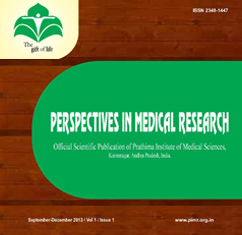
Original Articles
Year : 2016 | Volume : 4 | Issue : 2 Page : 39 - 43
V Usha rani1, A.Vivekanand2, Suvarna3
1Assistant Professor, Department of Obstetrics & Gynecology, Kakatiya Medical College,Warangal,Telangana, 2Professor, Department of Obstetrics & Gynecology, Prathima Institute of Medical Sciences,Karimnagar,Telangana,India, 3Postgraduate. Student, Department of Obstetrics & Gynecology, Prathima Institute of Medical Sciences,Karimnagar,Telangana,India.
Address for correspondence: V Usha rani, 1Assistant Professor, Department of Obstetrics &Gynecology, Kakatiya Medical Collges,Warangal,Telangana, India.
Email: [email protected]
Introduction:Bacterial vaginosis (BV) affects 6–32% of pregnant women. BV is a risk factor for Preterm delivery and is also associated with peripartum complications such as
Preterm premature rupture of membranes (PPROM), chorioamnionitis, and
Postpartum endometritis. As Bacterial vaginosis in pregnancy is receiving extensive
attention as a cause of preterm labour, a comprehensive prospective study was
proposed to be undertaken to find out incidence of Bacterial vaginosis in preterm
labour in hospital setting with simultaneous medical intervention to prevent premature birth as far as possible.
Aims & Objectives: To study incidence of bacterial vaginosis in preterm and term labour, to study association of bacterial vaginosis with preterm labour (PTL) and to study perinatal outcome in bacterial vaginosis positive cases
Material and Methods: Fifty women who presented with preterm labour (study group) and fifty women in labour at term (control group) admitted in the Department of Obstetrics and
Gynecology, Prathima Institute of Medical sciences, Karimnagar from December
2013 to June 2015 were examined for Bacterial Vaginosis using Amsel criteria and
Nugent score. Maternal age, socioeconomic status (SES), previous pregnancy outcome, onset of Preterm birth to delivery, birth weight and Apgar score were all noted. All
babies of both groups followed up to first week of neonatal life.
Results: The incidence of bacterial vaginosis in patients with idiopathic preterm labour was 24 percent and among term group was 8 percent. Bacterial vaginosis was significantly
(P >0.05) associated with idiopathic preterm labour. Out of 16 patients who had
bacterial vaginosis, 12 had preterm delivery (>37 weeks). In 84 patients without bacterial vaginosis 38 had preterm delivery. Bacterial vaginosis was significantly
associated with low birth weight babies (P >0.05). Bacterial vaginosis was
significantly associated with neonatal jaundice and neonatal sepsis and neonatal
death.
Conclusion: This study shows that BV is significantly associated with preterm birth and is one of the most important causes of PTL leading to various neonatal mortality, morbidity and even permanent disability. Also prevention of PTL in pregnant women decreases the incidence of postpartum endometritis and hence reduces maternal morbidity. Methods and materials to detect bacterial vaginosis is very simple, can be carried out as outdoor procedure. If diagnosed in the early part of pregnancy and treated with antimicrobial therapy, then perhaps we can decrease the burden of prematurity which will be great benefit for society and Nation
Keywords :Bacterial vaginosis, Preterm labour, Perinatal outcome

Open Access
Perspectives in Medical Research is committed to keeping research articles Open Access.Journal permits any users to read, download, copy, print, search, or link to the full texts of these articles...
Read more
